Lenovo ThinkStation P360 Ultra Power Consumption and Noise
We have a high-end configuration. Even with that, the typical idle is in the 26-31W range. Maximum power consumption can peak well above 210-220W in this configuration.
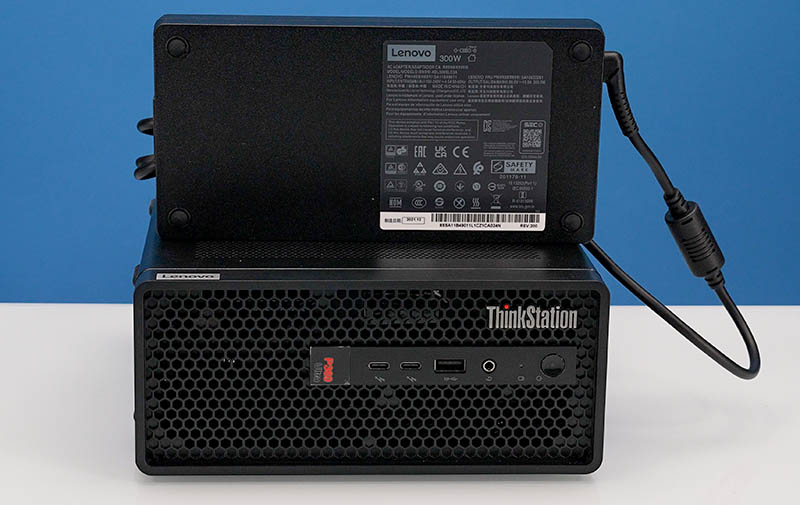
The power supply is an external 300W power brick that is massive. Although this power adapter can be shared with notebooks, taking out the power supply to keep the system under 4L seems strange. It should just be built in at this point.
One item that is very noticeable is the noise. In the video, we show how quiet it is at idle, not noticeable in the 34dba studio. This is far from a quiet system under load. We have a section of the video where we talk about the noise, and you can certainly hear it and it bring the studio up to 54-56dba. This should vary with configuration as we have a very high-end config here.
Key Lessons Learned
Perhaps the biggest key lesson learned is that the dual-sided motherboard design really helps this system. Lenovo is able to pack in functionality well beyond what we would see in most mITX platforms because of this design. Having the ability to use four SODIMM slots for 128GB and even having an extra PCIe slot was really nice in this type of platform.
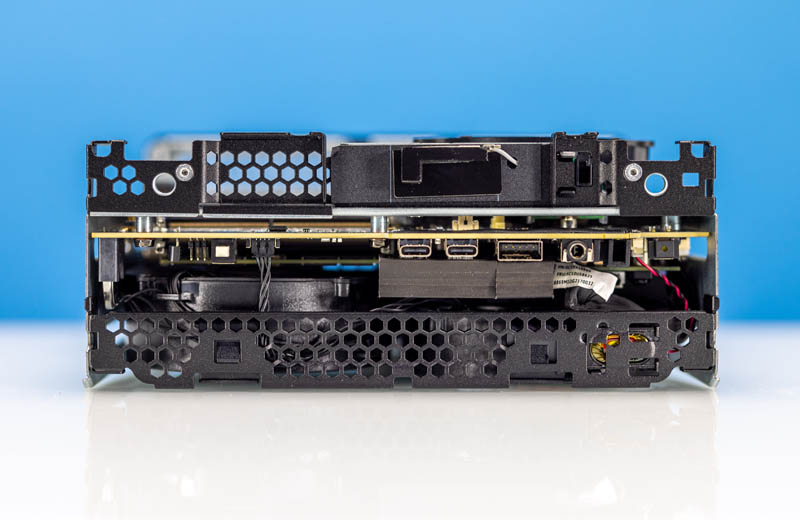
The NVIDIA RTX A5000 16GB card totally changes what one can do in such a small platform. This is so far beyond an iGPU solution and is even much more performance than the NVIDIA P620, T1000, and other small GPUs we see in the 1L piece.
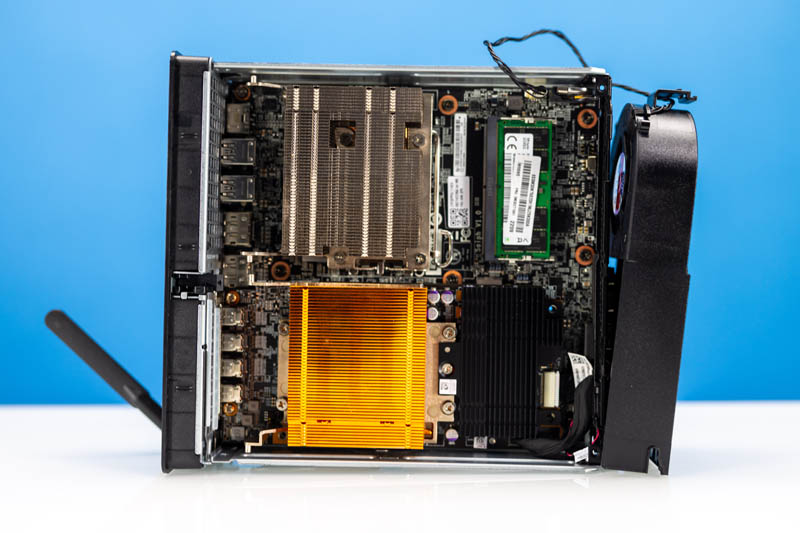
Power consumption and noise are certainly much higher. That also means we have a 300W PSU. Our sense is that Lenovo really needs to integrate that at some point as it is a glaring difference between this workstation and the Apple Mac Mini M2 Pro.
Final Words
Overall, the 1L PCs, including many of the workstations we have reviewed, are awesome. At some point, though, when you need more ports, expandability, and performance, you need something bigger. The Lenovo ThinkStation P360 Ultra is a large step up in performance without having to go to a full desktop tower design like the Lenovo ThinkStation P620.
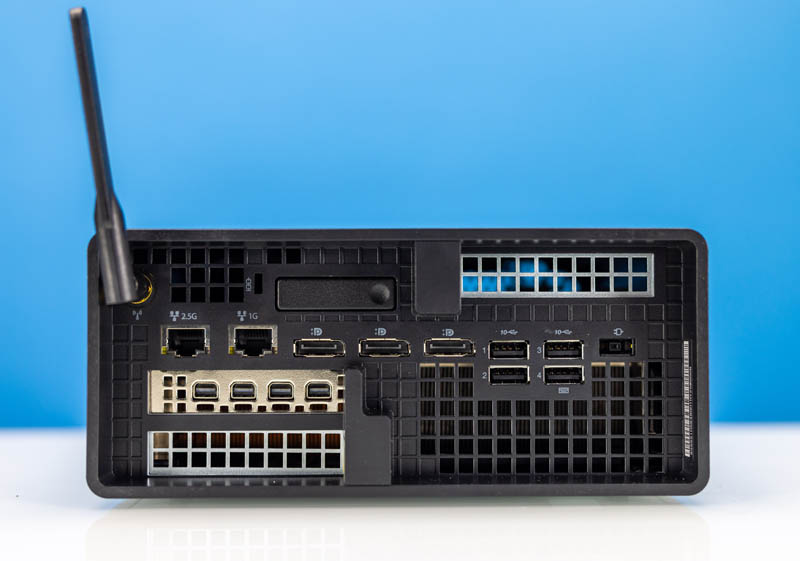
Overall, Lenovo did a great job with ports, including dual Ethernet (although we would have liked to have seen at least dual 2.5GbE in this) and even Thunderbolt ports. The addition of more expansion through ports and slots means it addresses many of the comments we get in the 1L Project TinyMiniMicro series.
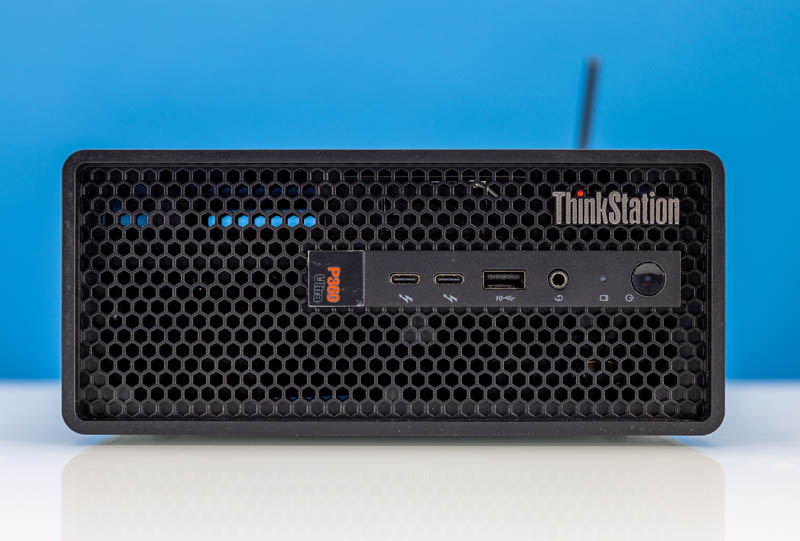
There is a lot to like in this small PC. It is probably not enough to make a large organization that buys exclusively Dell or HP switch to Lenovo. On the other hand, it is going to be great for those who are already in the Lenovo ecosystem or who do not standardize. We can see this as a very attractive alternative to those who want something that is Windows or Linux-based to compete with a Mac Studio.




To be fair, for this price point I would have hoped to see an integrated 10G NIC. I know that one could just add it in the extra slot, but then that takes away the opportunity of using it for more specialized equipment, such as a professional sound or video capture card.
I think that is totally right Robert. 10Gbase-T (or even SFP+ with the option for a SFP+ to 10Gbase-T adapter) would have been really nice especially with the Mac Studio out there.
What’s funny is they are listing this as a RTX A5000 Mobile (https://www.techpowerup.com/gpu-specs/rtx-a5000-mobile.c3805).. which is spec for spec the exact same as a RTX A4000 (https://www.techpowerup.com/gpu-specs/rtx-a4000.c3756)
The real interesting part is if this is on a seperate PCB (which it looks like it is, would love a picture of just the card) this now sits at the highest power Low Profile GPU on the market. Basically giving you a 3080 in a Two-Slot LP form factor.
This GPU is kinda bonkers and would love to see more tests of it specifically as well as a breakdown of the PCB and how they are able to get the power consumption to work in this chassis.
Anyways I thoroughly love the SFF content on here and hope for more TMM related content in the future!
Sadly no 10Gbps NIC, sadly A5000, not 3080 or 3090
I thought Lenovo stopped using those rectangle power connectors. Stupid non-standard connector.
I would have liked to see the Geekbench 6 results for the Mac Studio with the M1 Max and M1 Ultra thrown into your mix of results as well.
I looked them up myself, and the M1 Max results weren’t too far off what you got here. Of course the OpenCL results were higher for the NVidia card, but you could spec an M1 Max Studio for $2799 ($1500 less than you listed for this) with 64GB RAM and a 4TB NVMe.
Of course, the Studio isn’t upgradeable, but for that price difference you could just buy an M2 Mini if you need more ports! :)
Oops, Sorry. I meant to type $3,799 ($500 less). My bad.
I don’t understand the form factor. It’s small enough to put on a desk next to the monitor but the fans are too loud. Is this intended for gaming where the user wears a sound-isolating headset? Do video content creators usually wear headsets while they are working?
This is a nice step up from the Dell Precision 3260 Compact
I just purchased one… I need to create a solution for a future MacBook Air loving Aerospace Engineering major that will need the ability to run SolidWorks and other x86/AMD64 software that does not run on a M1/M2. Plus I LOVE SMALL POWERFUL COMPUTERS…
It utilises a W680 motherboard so does ECC sodimm ram usable here ?
Yes you can get custom configurations with ECC memory. None of the standard configurations have ECC. I have 2 32GB ECC SODIMMs. On the A2000 at least (the config I own) you can also enable ECC on the GPU. The things I would prefer would be a SDCard slot on the front (to download from cameras), and the ability to adjust the P1 power throttle. The default is up to 56 seconds thermal throttled (Tau), and then the P1 limit takes it down to 75W, performance and fan noise go down. The fan is lot noisier when thermal throttled, but if I were doing a 15 minute render, I might prefer noisy and 20%+/- more performance. A 5 year on site repair warranty was only $111 so perhaps Lenovo feels running above the rated CPU TDP degrades long term reliability.
Just got one of these P360 Ultras and put esxi 8.0 on it. Seemed great until I spun up an Ubuntu VM to be a dhcp server. Looks like the on board NIC (port 0) blocks/intercepts outgoing UDP port 68 packets (aka DHCPOFFER). I tried disabling MEBx/vpro, but didn’t seem to matter.